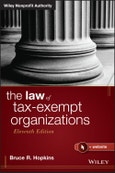The definitive legal guide for tax–exempt organizations
Tax–exempt organizations are subject to a complex set of statutes, regulations, and case law that are as diverse as the organizations that are covered. Lawyers, managers, accountants, directors, officers, and executives for nonprofit organizations are subject to special rules that govern practices such as how an organization must be organized, methods of measuring unrelated business income, and much more. To keep abreast of the ever–changing tax laws, you need a reliable reference that is written in plain English. The Law of Tax–Exempt Organizations, Eleventh Edition and the companion website offers a clear understanding of the evolving statutes, regulations, and court decisions in order to help you make informed decisions.
Organized to be easily accessible, The Law of Tax–Exempt Organizations is written by Bruce R. Hopkins, one of the country′s leading legal authorities on the topic. No matter what your professional experience new to the field or a well–established practitioner this vital resource contains information on targeted aspects of tax laws and regulations as well as a quick refresher course on recent changes to the laws related to tax–exempt organizations.
With detailed documentation and citations on Internal Revenue Code citations, references to regulations, IRS rulings, court opinions, tax law literature, current articles, tax law review notes, tables of cases, and tables of IRS rulings, this publication is supplemented annually with significant updates on the latest developments in:
- Nonprofit governance
- Legislative and political activity
- New rules for donor–advised funds
- New rules for supporting organizations
- Expanded discussion of private benefit doctrine (to reflect recent IRS ruling activity)
- Updates on unrelated business activities
- Use of subsidiaries and joint ventures
Comprehensive, reliable, and accessible, this essential guide is the resource you will turn to time and again for the dependable advice you need to understand complicated tax law issues.
For more information on this and all of Bruce Hopkins′s nonprofit law publications, visit wiley.com/go/Hopkins
Table of Contents
About the Author xxvii
Preface xxix
About the Online Resources xxxiii
Book Citations xxxv
PART ONE: INTRODUCTION TO THE LAW OF TAX–EXEMPT ORGANIZATIONS
1 Definition of and Rationales for Tax–Exempt Organizations 3
2 Overview of Nonprofit Sector and Tax–Exempt Organizations 23
PART TWO: FUNDAMENTALS OF THE LAW OF TAX–EXEMPT ORGANIZATIONS
3 Source, Advantages, and Disadvantages of Tax Exemption 43
4 Organizational, Operational, and Related Tests and Doctrines 61
5 Nonprofit Governance 133
PART THREE: TAX–EXEMPT CHARITABLE ORGANIZATIONS
6 Concept of Charitable 159
7 Charitable Organizations 191
8 Educational Organizations 263
9 Scientific Organizations 287
10 Religious Organizations 295
11 Other Charitable Organizations 329
12 Public Charities and Private Foundations 343
PART FOUR: OTHER TAX–EXEMPT ORGANIZATIONS
13 Social Welfare Organizations 385
14 Business Leagues and Like Organizations 401
15 Social Clubs 429
16 Labor, Agricultural, and Horticultural Organizations 445
17 Political Organizations 455
18 Employee Benefit Funds 469
19 Other Categories of Tax–Exempt Organizations 491
PART FIVE: PRINCIPAL EXEMPT ORGANIZATION LAWS
20 Private Inurement and Private Benefit 547
21 Intermediate Sanctions 595
22 Legislative Activities by Tax–Exempt Organizations 625
23 Political Campaign Activities by Tax–Exempt Organizations 657
24 Unrelated Business: Basic Rules 685
25 Unrelated Business: Modifications, Exceptions, and Special Rules 767
PART SIX: ACQUISITION AND MAINTENANCE OF TAX EXEMPTION
26 Exemption Recognition and Notice Processes 795
27 Administrative and Litigation Procedures 835
28 Operational Requirements 877
PART SEVEN: INTERORGANIZATIONAL STRUCTURES AND OPERATIONAL FORMS
29 Tax–Exempt Organizations and Exempt Subsidiaries 949
30 Tax–Exempt Organizations and For–Profit Subsidiaries 965
31 Tax–Exempt Organizations and Joint Ventures 987
32 Tax–Exempt Organizations: Other Operations and Restructuring 1017
PART EIGHT: APPENDIXES
Index 1085








